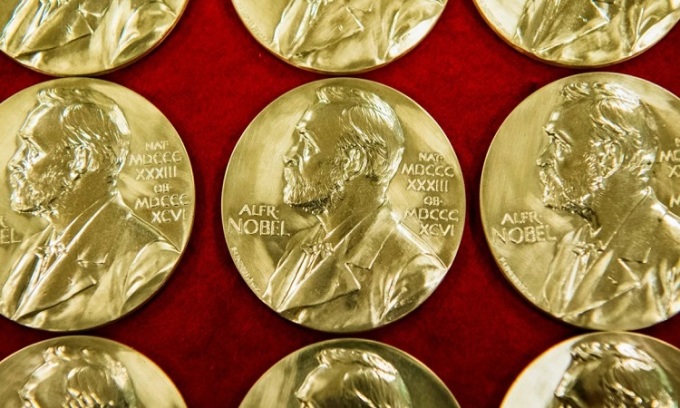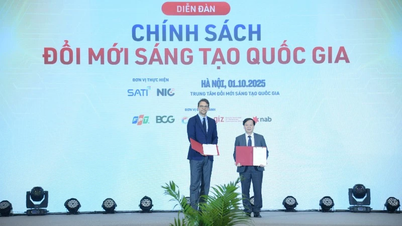The Nobel Prize has been criticized for awarding prizes to only three people in a field, despite research that may be the work of large teams.

The Nobel Assembly selects three people to award the prize according to the rules set by founder Alfred Nobel. Photo: Jonathan Nackstrand/AFP
Some of the brightest minds in the scientific community will be honored earlier this week with the announcement of the Nobel Prizes in Physiology or Medicine (October 2), Physics (October 3) and Chemistry (October 4). The awards, established more than a century ago by Swedish industrialist Alfred Nobel, represent the pinnacle of scientific achievement, honoring revolutionary breakthroughs that are the result of decades of research, according to CNN .
In addition to the fame, the prize sometimes sparks controversy and anger about who is chosen and who is rejected, according to Martin Rees, a British cosmologist and physicist who is a former president of the Royal Society, the world's oldest scientific society. One challenge for the Nobel committee, Rees says, is the increasing collaboration that is common in much of science. The image of a lone genius making a discovery has long since disappeared. In addition, discoveries can be made simultaneously by different research groups.
However, under rules set by Alfred Nobel in 1895, the Nobel committee can only honor a maximum of three people per prize. This requirement is a headache. "It could be a project where several people are working in parallel and they cannot exclude each other. It could also be a team and it is not certain that the people who are left out are not key individuals," Rees said.
For example, the 2017 Nobel Prize in Physics recognized the discovery of gravitational waves, “ripples” in space created by colliding black holes more than a billion light-years from Earth. The key papers describing the discovery had nearly 1,000 authors. However, only three were awarded the prize: Rainer Weiss, Barry Barish, and Kip Thorne. Similarly, a frequently discussed candidate for the Nobel Prize in Physiology or Chemistry is the mapping of the human genome, a revolutionary project that will not be completed until 2022 and will involve hundreds of people.
David Pendlebury, director of research analytics at the Institute for Scientific Information, who identifies individuals who are “Nobel-worthy” by analyzing how much their peers cite their key scientific work over the years, agrees that the rule of three is a source of pressure. “Science is really undergoing a huge transformation, with more and more research groups tackling difficult problems through international collaborations. The rule of three seems to be an obstacle to them recognizing a group,” Pendlebury said.
The rule that the prize can only be awarded to three people comes from the statutes of the Nobel Foundation, which is responsible for carrying out Nobel's will. Peter Brzezinski, secretary of the Nobel Chemistry Prize committee, said there were no plans to change the rule. However, he said the committee followed a detailed procedure after candidates were nominated in late January.
“We start the process by asking a number of experts from around the world to write papers describing the field of discovery, to outline the main works in the field and to mention the individuals who have made the most important contributions,” Brzezinski explains. “We read all the papers, attend workshops and write papers in committee. After a while, we usually succeed in identifying a small group of scientists behind the discovery. If we cannot do this, we cannot recommend the Academy for the prize.”
The Nobel Committee typically separates research published decades in advance, on the view that it takes time for the importance of some scientific research to become apparent. They also focus on three scientific fields specified in Alfred Nobel's will. Fields such as mathematics, computer science, Earth and climate sciences, and oceanography are excluded.
Even within biomedicine, physics, and chemistry, just five of the 114 different scientific disciplines accounted for more than half of the Nobel Prizes awarded between 1995 and 2017, according to a 2020 study. These were particle physics, atomic physics, cell biology, neuroscience, and molecular chemistry. But Rees stressed that considering the long-term consequences and giving greater recognition to certain fields sometimes makes the Nobel committee seem out of touch with today's scientific priorities.
One example is artificial intelligence (AI), which is transforming human life at an unprecedented pace. Two prominent names in the field are Demis Hassabis and John Jumper, inventors of Google DeepMind’s AlphaFold, an AI program that decodes the 3D structure of proteins from amino acid chains. They won the $250,000 Lasker Prize this year and the Breakthrough Prize last year. Although their research was published just two years ago, it has been cited more than 8,500 times, according to Pendlebury.
The Nobel committee sometimes awards prizes for recent discoveries, such as the 2020 Nobel Prize in Chemistry awarded to Emmanuelle Charpentier and Jennifer Doudna, less than 10 years after their 2012 paper on the CRISPR-Cas9 gene-editing technique, but Pendlebury said a Nobel for AI this year is still unlikely. He said the Nobel committee is “conservative.”
Another criticism of the Nobel Prize is the lack of diversity among its winners. More women have received calls from Stockholm in recent years, but that’s a drop in the bucket. Last year, Carolyn Bertozzi, who won the Nobel Prize in Chemistry, was the only woman named. No women were named in 2021 or 2019, when the Nobel committee asked nominators to consider diversity in terms of gender, geography, and field of study. Astrophysicist Andrea Ghez shared the Nobel Prize in Physics in 2020, the same year Doudna and Charpentier won the Nobel Prize in Chemistry.
Pendlebury believes the lack of diversity at the Nobel Prize is fundamentally a matter of numbers. "They're looking at research published 20 or 30 years ago, when there weren't as many prominent women scientists as there are today. So I think over time we'll see more women selected," Pendlebury says. Women are also less likely to be cited as lead scientists in scientific papers.
An Khang (According to CNN )
Source link





![[Photo] Hanoi morning of October 1: Prolonged flooding, people wade to work](https://vphoto.vietnam.vn/thumb/1200x675/vietnam/resource/IMAGE/2025/10/1/189be28938e3493fa26b2938efa2059e)
![[Photo] President of the Cuban National Assembly visits President Ho Chi Minh's Mausoleum](https://vphoto.vietnam.vn/thumb/1200x675/vietnam/resource/IMAGE/2025/10/1/39f1142310fc4dae9e3de4fcc9ac2ed0)
![[Photo] Keep your warehouse safe in all situations](https://vphoto.vietnam.vn/thumb/1200x675/vietnam/resource/IMAGE/2025/10/1/3eb4eceafe68497989865e7faa4e4d0e)
























































































Comment (0)